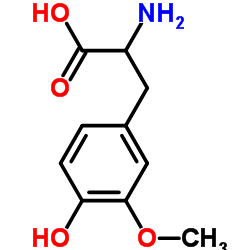Pharmacokinetic-pharmacodynamic interaction between nebicapone and controlled-release levodopa/benserazide: a single-center, Phase I, double-blind, randomized, placebo-controlled, four-way crossover study in healthy subjects.
Teresa Nunes, Rita Machado, José F Rocha, Carlos Fernandes-Lopes, Raquel Costa, Leonel Torrão, Ana I Loureiro, Amílcar Falcão, Manuel Vaz-da-Silva, Lyndon Wright, Luis Almeida, Patricio Soares-da-Silva
文献索引:Clin. Ther. 31(10) , 2258-71, (2009)
全文:HTML全文
摘要
Nebicapone is a reversible catechol-O-methyltransferase (COMT) inhibitor. Coadministration of a COMT inhibitor with levodopa and a dopa-decarboxylase inhibitor (carbidopa or benserazide) increases levodopa exposure and its therapeutic effect.The primary objective of this study was to investigate the effect of nebicapone (50, 100, and 200 mg), compared with placebo, on levodopa pharmacokinetics when coadministered with a single dose of controlled-release levodopa 100 mg/benserazide 25 mg. The secondary objectives were to investigate the effect of nebicapone on the erythrocyte-soluble COMT (S-COMT) activity and on the plasma levels of the levodopa 3-O-methylated metabolite (3-O-methyldopa [3-OMD]). Nebicapone's tolerability was also assessed.This was a single-center, Phase I, doubleblind, randomized, placebo-controlled, 4-way crossover study conducted in healthy adult volunteers. Each of the 4 single-dose treatment periods was separated by a washout period of > or = 5 days. During the different treatment periods, subjects received a single dose of controlled-release levodopa 100 mg/benserazide 25 mg concomitantly with nebicapone 50, 100, and 200 mg or placebo. Plasma concentrations of nebicapone, levodopa, and 3-OMD were determined by HPLC. Blood samples (7 mL) for determination of plasma concentrations of levodopa, 3-OMD, and 2258 nebicapone, as well as for the assay of S-COMT activity, were collected in potassium EDTA test tubes at the following times: predose and 0.5, 1, 1.5, 2, 3, 4, 6, 8, 12, 16, and 24 hours postdose. S-COMT activity was assessed as the amount of metanephrine formed by the action of S-COMT on an epinephrine substrate. Spontaneously reported clinical adverse events (AEs) were recorded throughout the study.Sixteen subjects (8 females, 8 males; mean [SD] age, 26.13 [6.29] years; weight, 69.4 [12.4] kg; body mass index, 24.0 [3.0] kg/m2) completed the 4 treatment periods and had data available for pharmacokinetic and pharmacodynamic analyses. Compared with placebo, levodopa C(max) increased 25%, 30%, and 34%, and AUC increased 14%, 37%, and 42% after administration of nebicapone 50, 100, and 200 mg, respectively. After administration of nebicapone 50, 100, and 200 mg, 3-OMD C(max) decreased 44%, 57%, and 58%, and 3-OMD AUC(0-infinity) decreased 33%, 37%, and 45%, respectively, compared with placebo. Extent of exposure to levodopa, as assessed by using AUC(0-t), increased with all doses of nebicapone in relationship to placebo, but the difference did not reach statistical significance. This may be related to a relatively high inter-subject variability: %CVs ranged from 48.0% with nebicapone 100 mg to 66.8% with placebo. Maximum S-COMT inhibition by nebicapone occurred at approximately 1.5 hours postdose and ranged from 57% with nebicapone 50 mg to 74% with nebicapone 200 mg. There was an inverse correlation between plasma concentrations of nebicapone and S-COMT activity; T(max) of nebicapone plasma concentrations and time to occurrence of the maximum inhibition of S-COMT activity appeared to correlate. Nineteen AEs were reported; 8 were assessed by the investigator as possibly related to treatment. All AEs were mild in severity. There were no serious AEs or discontinuations due to AEs. No abnormalities in liver enzyme levels were found.When administered concomitantly with a single dose of controlled-release levodopa 100 mg/benserazide 25 mg, single doses of nebicapone 50, 100, and 200 mg were well tolerated in these healthy adult volunteers, and dose dependently inhibited S-COMT activity and reduced 3-OMD formation compared with placebo. However, there was no significant difference in levodopa bioavailability.
相关化合物
| 结构式 | 名称/CAS号 | 分子式 | 全部文献 |
|---|---|---|---|
 |
2-氨基-3-(4-羟基-3-甲氧基苯基)丙酸
CAS:7636-26-2 |
C10H13NO4 |
|
Cysteinyl-glycine reduction as marker for levodopa-induced o...
2011-02-15 [Mov. Disord 26 , 543-546, (2011)] |
|
Pharmacokinetic-pharmacodynamic modeling of levodopa in pati...
2010-05-01 [Clin. Neuropharmacol. 33(3) , 135-41, (2010)] |
|
Levodopa infusion combined with entacapone or tolcapone in P...
2012-06-01 [Eur. J. Neurol. 19(6) , 820-6, (2012)] |
|
Comparison of 200 mg retarded release levodopa/carbidopa - w...
2007-01-01 [J. Neural Transm. Gen. Sect. 114(11) , 1457-62, (2007)] |
|
The role of 3-O-methyldopa in the side effects of L-dopa.
2008-03-01 [Neurochem. Res. 33(3) , 401-11, (2008)] |